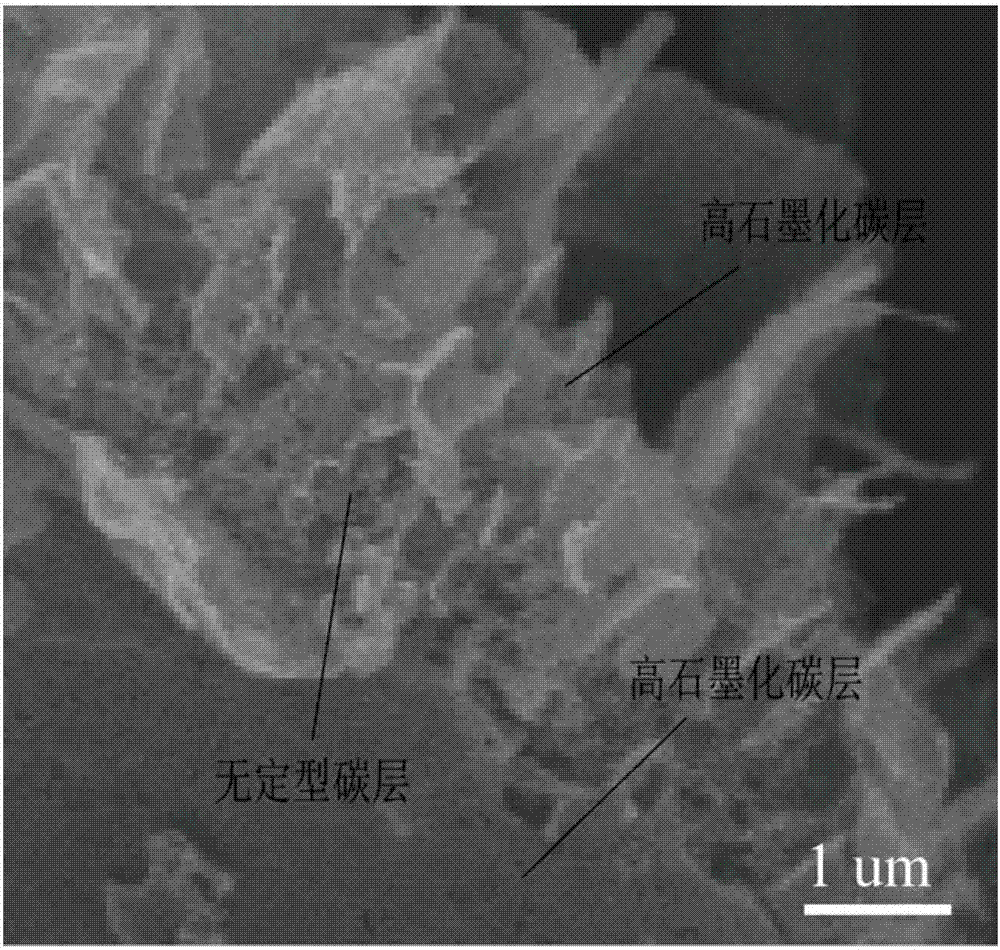Sandwich-structure carbon-base composite material as well as preparation method and application thereof
A carbon-based composite material, sandwich technology, applied in nanotechnology, structural parts, electrical components, etc. for materials and surface science, can solve problems such as poor conductivity and poor rate performance, and achieve good conductivity and high porosity. , good reproducibility
- Summary
- Abstract
- Description
- Claims
- Application Information
AI Technical Summary
Problems solved by technology
Method used
Image
Examples
Embodiment 1
[0050] Put 1 g of chitosan and 10 g of zinc nitrate in a ball mill jar, mill for 5 hours, carbonize at 600° C., and wash with water and ethanol to obtain a porous carbon nanosheet material.
[0051] Put 0.2g of the obtained porous carbon nanosheet material in a nickel chloride solution with a concentration of 0.1mol / L and soak it for 1h. 2 h 2 The gas flow rate is 1 mL / min, the argon gas flow rate is 100 mL / min, the temperature is 700° C., and the time is 5 h. The obtained material is washed and dried to obtain a sandwich structure carbon-based composite material. The thickness of the graphitized carbon layer is about 10nm, and the thickness of the amorphous carbon layer is about 200nm. The scanning electron microscope image of the obtained sandwich structure carbon-based composite material is as follows: figure 1 shown.
[0052] The sandwich-structured carbon-based composite material prepared in this example was used as the working electrode, and the sodium was used as th...
Embodiment 2
[0054] Put 1 g of chitosan and 100 g of zinc nitrate in a ball mill jar, mill for 5 hours, carbonize at 1200° C., and wash with water and ethanol to obtain a porous carbon nanosheet material.
[0055] Soak 0.2 g of the obtained porous carbon nanosheet material in a nickel chloride solution with a concentration of 1 mol / L for 10 h. After freeze-drying, place the obtained precursor in a CVD system, and control 2 h 2 The gas flow rate is 100mL / min, the argon gas flow rate is 1000mL / min, the temperature is 1000°C, and the time is 1h. The obtained material is washed and dried to obtain a sandwich structure carbon-based composite material. The thickness of the graphitized carbon layer is about 80nm, and the thickness of the amorphous carbon layer is about 100nm.
[0056] The carbon-based material with a sandwich structure prepared in this example is used as a working electrode, and sodium is used as a counter electrode, and assembled into a button battery. At a current density of ...
Embodiment 3
[0058] Put 1 g of chitosan and 20 g of zinc nitrate in a ball mill jar, mill for 4 hours, carbonize at 1000° C., and wash with water and ethanol to obtain a porous carbon nanosheet material. Soak 0.2 g of the obtained porous carbon nanosheet material in a nickel chloride solution with a concentration of 0.5 mol / L for 5 h, and after freeze-drying, place the obtained precursor in a CVD system and control 2 h 2 The gas flow rate is 10 mL / min, the argon gas flow rate is 100 mL / min, the temperature is 800° C., and the time is 3 h. The obtained material is washed and dried to obtain a sandwich-structured carbon-based material. The graphitized carbon layer has a thickness of 50 nm, and the amorphous carbon layer has a thickness of 150 nm.
[0059] The sandwich-structured carbon-based composite material prepared in this example was used as the working electrode, and the sodium was used as the counter electrode, and assembled into a button battery. At a current density of 50mA / g, th...
PUM
| Property | Measurement | Unit |
|---|---|---|
| thickness | aaaaa | aaaaa |
| thickness | aaaaa | aaaaa |
| thickness | aaaaa | aaaaa |
Abstract
Description
Claims
Application Information
 Login to View More
Login to View More - R&D
- Intellectual Property
- Life Sciences
- Materials
- Tech Scout
- Unparalleled Data Quality
- Higher Quality Content
- 60% Fewer Hallucinations
Browse by: Latest US Patents, China's latest patents, Technical Efficacy Thesaurus, Application Domain, Technology Topic, Popular Technical Reports.
© 2025 PatSnap. All rights reserved.Legal|Privacy policy|Modern Slavery Act Transparency Statement|Sitemap|About US| Contact US: help@patsnap.com

